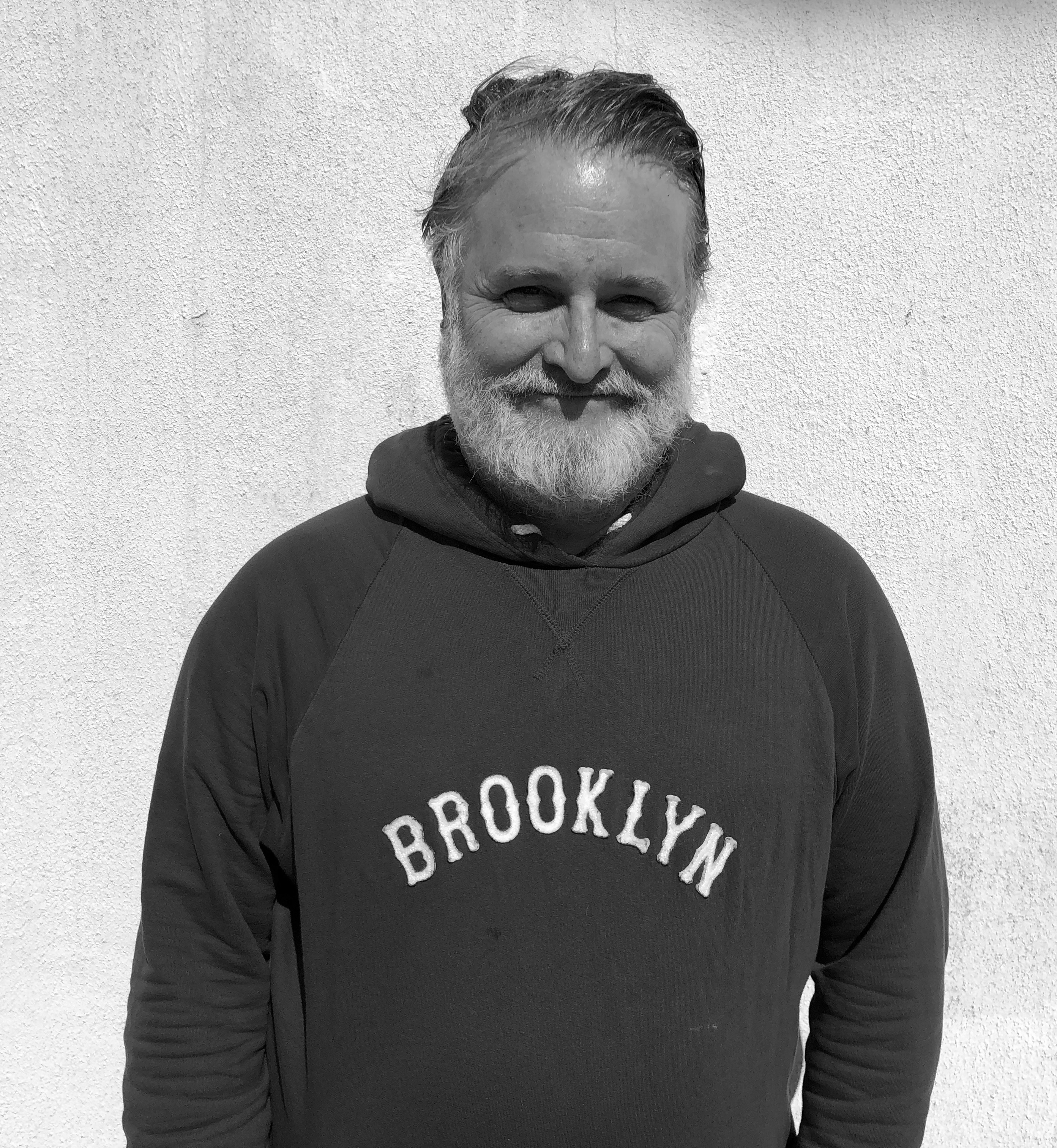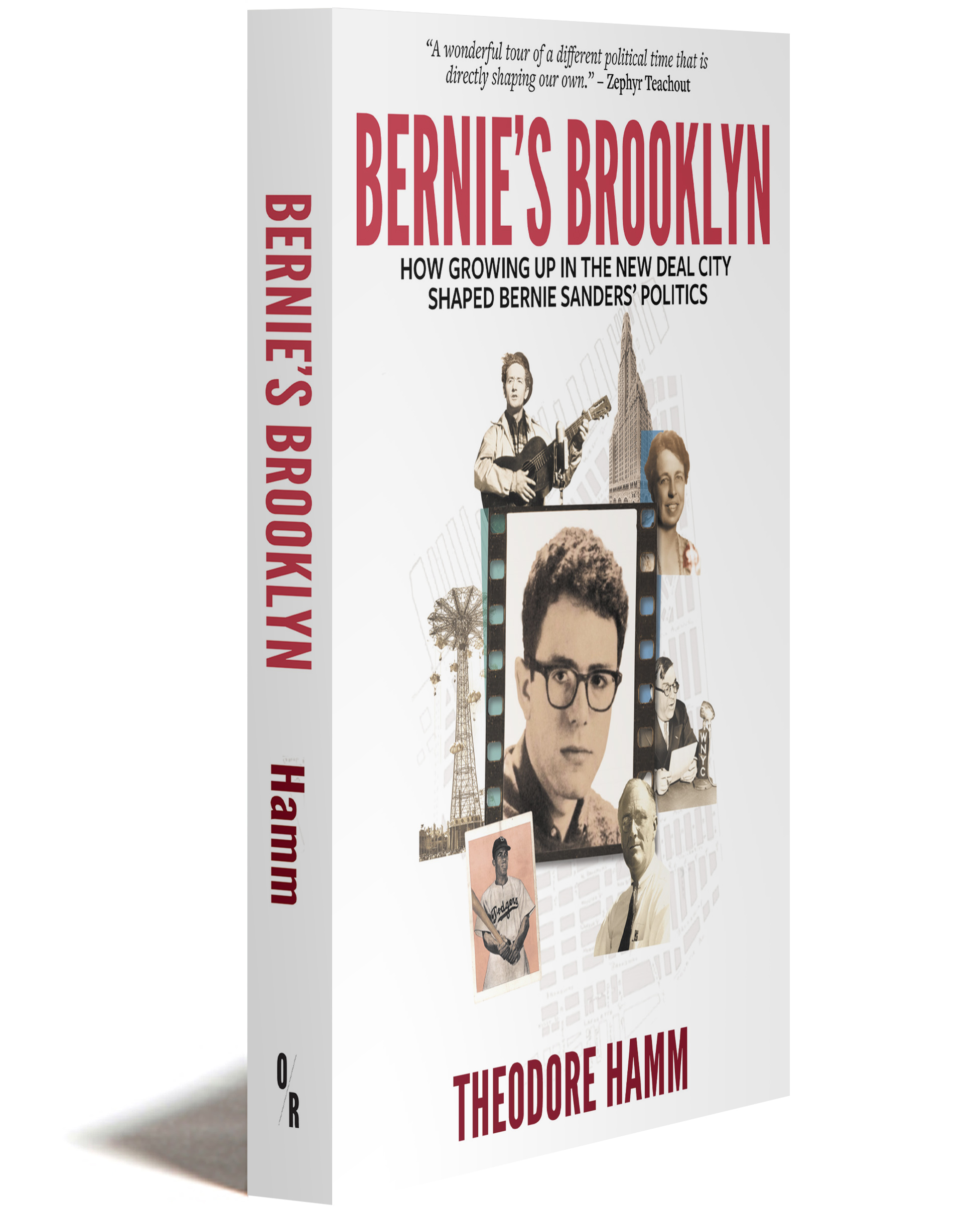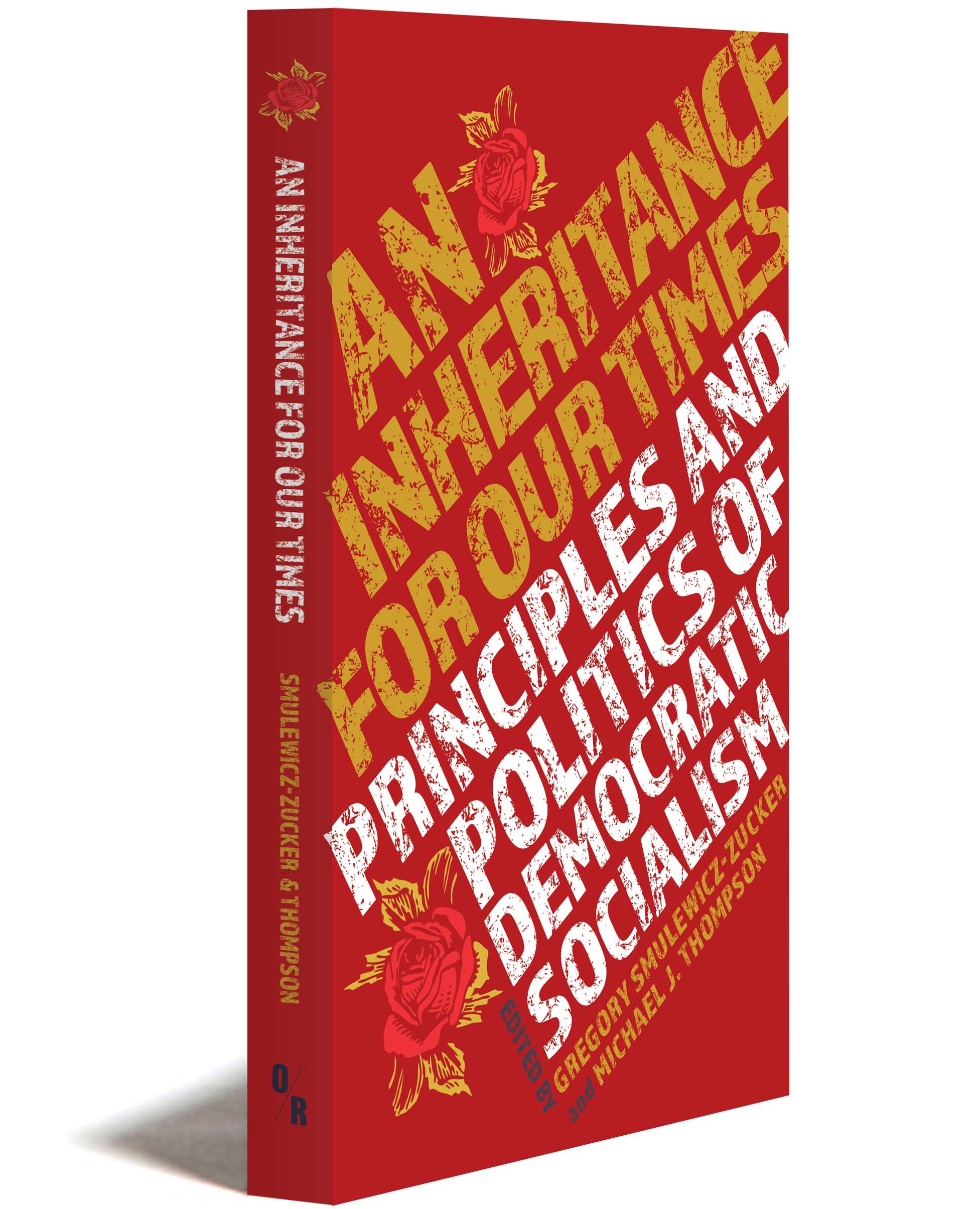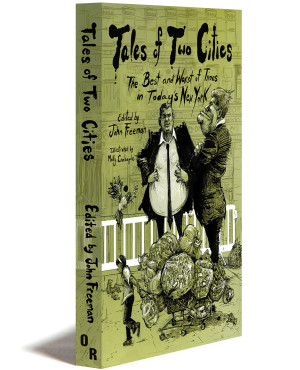Bernie's Brooklyn
HOW GROWING UP IN THE NEW DEAL CITY SHAPED BERNIE SANDERS' POLITICS
“A wonderful tour of a different political time that is directly shaping our own. Hamm's book is a beautiful, loving, and easy-to-read exploration of the texture of politics in Brooklyn while Sanders was a child, Bernie's Brooklyn brings politics and culture and context to life.” —Zephyr Teachout
“A treasure trove for Sanders fans.” —Liza Featherstone, columnist for Jacobin and The Nation
“An insightful exploration of the radical politics that dominated Brooklyn throughout the mid-20th century - politics which have taken root in the borough again in recent years.” —New York State Senator Jabari Brisport
Tweet
About the Book
Bernie Sanders’ tilt at the US presidency has come under fire from an establishment that derides his social democratic policies as alien to the American way. But, as Ted Hamm reveals in this engaging and concise history, the sort of socialism Bernie advocates was commonplace in the Brooklyn where he grew up in the 1940s and 50s.
Policies like free college tuition, rent control, and infrastructure projects including extensive public housing, parks and swimming pools were part of the New Deal city run by a progressive Mayor, Fiorello La Guardia, and supported by FDR and Eleanor Roosevelt. While Arthur Miller, resident in Brooklyn Heights, was staging Death of a Salesman, a play with which Bernie’s dad closely identified, Woody Guthrie was penning his paeans to the American worker in Coney Island and Jackie Robinson was breaking the color bar on Ebbets Field in a Dodgers team yet to be relocated in California.
Drawing deeply on interviews with his brother and friends, and delving skillfully into the history of the borough, Bernie’s Brooklyn shows how, far from being an anomaly in US politics, Sanders’ 2020 platform is rooted firmly in the progressivism of the New Deal.
228 pages • Paperback ISBN 978-1-68219-240-5 • E-book 978-1-68219-243-6
About the Author

Theodore Hamm is editor of Frederick Douglass in Brooklyn. He writes about New York City politics and culture for The Indypendent and Jacobin. Hamm is chair of journalism and new media studies at St. Joseph’s College in Clinton Hill, Brooklyn.
Read an Excerpt
From the Introduction
The contempt shared by the party’s elite for Bernie’s democratic socialist vision is further illustration of how far the Democrats have moved from FDR and the New Deal. Like many key figures in his administration, Roosevelt was a Keynesian capitalist, not a socialist. Neither were the coterie of middle-class reformers FDR brought to Washington from New York City’s settlement house movement of the Progressive Era. But the New Deal’s policies were not simply the handiwork of far-sighted technocrats. Instead, FDR’s team responded to pressure exerted from below. The Great Depression had spawned both labor militance, leading to a strike wave that shut down the West Coast waterfront in 1934; and social movements, including the retirement pension campaign led by Dr. Francis Townsend that had launched a year earlier. In 1935, both efforts helped create two of the New Deal’s most enduring legacies: the right for unions to organize and strike (as stipulated by the Wagner Act) and the Social Security system. Yet when FDR and prominent allies such as New York City mayor Fiorello La Guardia spoke of the president’s “social security program,” the lowercase term referred to far more than simply pensions. As FDR outlined in his “Economic Bill of Rights” (1944) and other speeches, he viewed it as the federal government’s responsibility to provide jobs, health care, and secure housing for the American people. Rather than democratic socialism, FDR created a blueprint for social democracy akin to what exists in many European countries today.
Many fundamental elements of Bernie’s 2020 agenda—including free college tuition, rent control and massive federal investment in housing, and vast public works projects that provide public-sector jobs (now the Green New Deal)—were realities in the Brooklyn where he grew up. Although FDR viewed health care as a right, and his successor Harry Truman began to push for national health insurance soon after he took office in 1945, no universal medical care system was implemented. But New York City had a vast, low-cost healthcare network that was accessible to both union members and non-union households such as the Sanders family. While Bernie’s proposal for Medicare for All is thus an extension of a landmark initiative of the Great Society, LBJ’s administration essentially continued to enact FDR’s domestic blueprint. As historian Kim Phillips-Fein demonstrates in Fear City (2017), the Wall Street-led response to New York’s fiscal crisis of the mid-1970s helped launch the neoliberal agenda of privatization within the Democratic Party. The same Clinton crowd that championed neoliberal “Third Way” rollbacks of New Deal policies not coincidentally loathes a candidate that adheres to FDR’s principles. As Bernie, who was born in 1941, stated in a November 2015 campaign speech at Georgetown University about democratic socialism, FDR stressed in his Second Bill of Rights speech that “real freedom must include economic security.” “That was Roosevelt’s vision seventy years ago,” he declared. “It is my vision today.” During that same campaign Bernie’s older brother, Larry (b.1935), explained that the siblings and their peers grew up “in an environment where New Deal politics were quite normal. It was widely understood that the government could do good things.” With post-Reagan Republicans deriding all social spending, and post-Clinton Democrats fetishizing private sector solutions to public problems, the origins of the Sanders brothers’ view of government’s positive potential is well worth exploring.
Socialism, of course, comes in many different varieties, and the one that most influenced the Sanders brothers in their early years was distinctly tied to their religious heritage. By 1950, nearly one million Jews lived in Brooklyn. The Sanders family was part of a Jewish enclave near Kings Highway in Midwood, which was then considered to be a section of the larger neighborhood of Flatbush (which had a large Irish Catholic population). While Larry and Bernie’s father, Eli Sanders, had immigrated from modern-day Poland in 1921, their mother, Dorothy “Dora” Glassberg, was born in New York City and went to high school in the Bronx. Dora’s father was a committed socialist and a union activist in the garment industry. As the historian Daniel Katz has argued, the perspective that grew out of that working-class milieu during the early twentieth century is best understood as Yiddish Socialism. Rather than a doctrinaire set of views regarding political strategy, adherents shared a strong set of cultural values, including that government should provide basic necessities, all ethnic and racial groups should be treated equally, and all people should be able to develop their full potential through education. Such aspirations became signature features of the New Deal’s “social security program.” As Katz explains, in the wake of the anti-Communist hysteria of the early Cold War period, the native-born generation of Jews coming of age in the 1950s like the Sanders brothers experienced the “transition from Yiddish Socialism to Jewish Liberalism,” which tempered expectations surrounding the role of government in creating equality. Although neither Eleanor Roosevelt nor her close ally—and two-time Democratic presidential candidate—Adlai Stevenson were Jewish, both were revered figures in Bernie’s neighborhood. The first political event Bernie recalls attending was a Stevenson rally held at his elementary school when he was in eighth grade.
During the New Deal through the end of World War II, the two most important political figures in New York City were FDR and his close ally, Mayor Fiorello La Guardia (1934–1945). With FDR’s administration providing a steady stream of funding, La Guardia and the urban planner Robert Moses built modern New York City. Among the “good things” La Guardia’s administration constructed during the period were the city’s grand W.P.A.-funded outdoor swimming pools, as well as hundreds of playgrounds, including one right around the corner from the Sanders family’s home. After New Deal money dried up amid the war effort, La Guardia and Moses created a blueprint that the latter enacted after the war, which included vast expansion of the city’s public housing system, what’s now JFK Airport, and a dizzying array of expressways (many of which proved to be not at all good for the neighborhoods they sundered). Led by its dynamic labor movement, New York City in the two decades after World War II became what historian Joshua Freeman has called “a social democratic polity . . . committed to an expansive welfare state, racial equality, and popular access to culture and education.” As just one of many examples, the City University of New York (CUNY) underwent a vast expansion in the 1950s and 1960s and did not charge tuition until the aftermath of the fiscal crisis of the mid-1970s. For working-class people and lower-middle-class families like Bernie’s, CUNY provided the opportunity for social mobility. In the mid-1950s, Larry Sanders attended Brooklyn College, where he became politically active and influenced his younger brother to follow suit. While their mother was ill, Bernie attended the same CUNY school, where he was first introduced to the work of his favorite historical figure, Socialist leader Eugene Debs.
While New York remained a social democratic city through the 1950s, Brooklyn became a central presence in American culture. In American arts and letters, on the baseball diamond, and in living rooms across the country, Brooklyn was a familiar place. By the early 1950s, Brooklyn-based novelist Norman Mailer, playwright Arthur Miller, and poet Marianne Moore were household names. Eli Sanders, a paint salesman, directly identified with the struggles faced by Willy Loman, Miller’s signature character. In April 1947, Jackie Robinson broke the color line in America’s national pastime at Ebbets Field, a place frequented by Larry and Bernie. From the middle of the war through the early 1950s, Woody Guthrie called Coney Island home. The songwriter memorably depicted a place full of summertime joys but also residential segregation, a practice enforced by his racist landlord Fred Trump. Woody’s music would travel with Bernie through Vermont onto the 2016 campaign trail. By the time Bernie graduated from high school, most of the leading cultural figures of the past decade had moved out of Brooklyn. And so too had the Dodgers, a betrayal that scarred a generation. Like many of his peers, Bernie left Brooklyn during his college years and returned only periodically. But in ways far deeper than simply his accent and mannerisms, Brooklyn never left Bernie.
In the Media
- “[Captures] how the New Deal was actually lived at the ground level by Bernie’s generation” — BERNIE’S BROOKLYN featured in the Jewish Currents newsletter (4/16/2021)
- “Favourite Reads in 2020” — BERNIE’S BROOKLYN recommended on the Repeater Books Blog (12/21/2020)
- “AOC For NYC Mayor in 2021” — BERNIE’S BROOKLYN author Theodore Hamm writes for the Indypendent (12/1/2020)
- “Brooklyn borough president candidate Robert Cornegy rails against ‘political gentrification’ by socialist upstarts while lining his coffers with campaign contributions from high-end real estate developers.” — BERNIE’S BROOKLYN author Theodore Hamm writes for the Indypendent (11/24/2020)
- “Facebook Sued Over Kenosha Killings” — BERNIE’S BROOKLYN author Theodore Hamm writes for the Intercept (9/25/2020)
- “The New York City Left Could Get a Chance to Define the Post-COVID City” — BERNIE’S BROOKLYN author Theodore Hamm writes for Jacobin (9/18/2020)
- “From Humble Beginnings to New York’s ‘Upper Echelons,’ Tali Weinstein Sets Her Sights On the Manhattan DA’s Office” — BERNIE’S BROOKLYN author Theodore Hamm interviews Tali Weinstein for the Indypendent (8/21/2020)
- “A Life-Long Fight For Justice Spurred Alvin Bragg Into the Manhattan DA Race” — BERNIE’S BROOKLYN author Theodore Hamm interviews Alvin Bragg for the Indypendent (8/14/2020)
- “The Rise of Hakeem Jeffries Is Being Disrupted From Below” — BERNIE’S BROOKLYN author Theodore Hamm writes for the Intercept (8/14/2020)
- “How Brooklyn Turned Bernie Sanders Into a Democratic Socialist” — BERNIE’S BROOKLYN author Theodore Hamm interviewed on Scheer Intelligence (8/7/2020)
- “In Bernie’s Brooklyn, Political Revolution Was Mainstream” — BERNIE’S BROOKLYN excerpt published in Jacobin (7/20/2020)
- NEW VIDEO: BERNIE’S BROOKLYN author Theodore Hamm interviewed on the Katie Halper Show (7/6/2020)
- “Bernie Sanders’s Socialism Is New York Born and Bred” — BERNIE’S BROOKLYN author Theodore Hamm interviewed by Public Seminar (6/26/2020)
- “How growing up in a New Deal city shaped Bernie Sanders’s vision for America” — BERNIE’S BROOKLYN excerpt published in Public Seminar (6/26/2020)
- “The World in Which Bernie Sanders Grew Up” — BERNIE’S BROOKLYN excerpt published on Lit Hub (6/18/2020)
- “Heastie-Controlled Slush Fund Props Up Embattled NY State Assembly Incumbents” — BERNIE’S BROOKLYN author Theodore Hamm writes for the Indypendent (6/18/2020)
- “Media-Darling Cop Terence Monahan’s Legacy of Brutality” — BERNIE’S BROOKLYN author Theodore Hamm writes for the Indypendent (6/9/2020)
- “Frank Sinatra, Woody Guthrie, Arthur Miller & the Reds on the Brooklyn Waterfront” — BERNIE’S BROOKLYN excerpt published in the Indypendent (6/5/2020)
- “Albany County District Attorney David Soares, once a promising criminal justice reformer, faces primary challenge from the left” — BERNIE’S BROOKLYN author Theodore Hamm writes for the Intercept (6/1/2020)
- “Far from being totally alien to the American way, the sort of socialism Bernie advocates was commonplace where he grew up” — BERNIE’S BROOKLYN excerpt published on ScheerPost (5/25/2020)
- “We Can’t Lose the Right to Protest in the Age of Coronavirus” — BERNIE’S BROOKLYN author Theodore Hamm writes for Jacobin (5/13/2020)
- “Bernie Sanders owes more to Brooklyn than his accent. His politics were profoundly shaped by its radicalism—from New Deal reforms to the Yiddish socialism that brought his grandparents into active politics.” — BERNIE’S BROOKLYN excerpt published in Tribune (4/9/2020)






